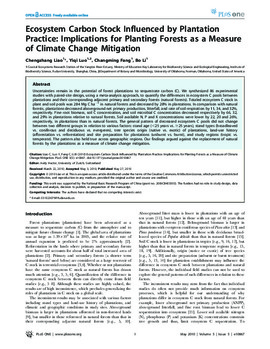| dc.contributor.author | Chengzhang Liao | en_US |
| dc.contributor.author | Yiqi Luo | en_US |
| dc.contributor.author | Changming Fang | en_US |
| dc.contributor.author | Bo Li | en_US |
| dc.date.accessioned | 2015-01-23T17:17:29Z | |
| dc.date.accessioned | 2016-03-30T15:35:49Z | |
| dc.date.available | 2015-01-23T17:17:29Z | |
| dc.date.available | 2016-03-30T15:35:49Z | |
| dc.date.issued | 2010-05-27 | en_US |
| dc.identifier.citation | Liao C, Luo Y, Fang C, Li B (2010) Ecosystem Carbon Stock Influenced by Plantation Practice: Implications for Planting Forests as a Measure of Climate Change Mitigation. PLoS ONE 5(5): e10867. doi:10.1371/journal.pone.0010867 | en_US |
| dc.identifier.uri | https://hdl.handle.net/11244/14062 | |
| dc.description | Thanks to the many researchers who provided additional detailed information, especially those who shared their raw data with us. | en_US |
| dc.description | Conceived and designed the experiments: CL YL CF BL. Analyzed the data: CL YL CF BL. Wrote the paper: CL. | en_US |
| dc.description.abstract | Uncertainties remain in the potential of forest plantations to sequestrate carbon (C). We synthesized 86 experimental studies with paired-site design, using a meta-analysis approach, to quantify the differences in ecosystem C pools between plantations and their corresponding adjacent primary and secondary forests (natural forests). Totaled ecosystem C stock in plant and soil pools was 284 Mg C ha−1 in natural forests and decreased by 28% in plantations. In comparison with natural forests, plantations decreased aboveground net primary production, litterfall, and rate of soil respiration by 11, 34, and 32%, respectively. Fine root biomass, soil C concentration, and soil microbial C concentration decreased respectively by 66, 32, and 29% in plantations relative to natural forests. Soil available N, P and K concentrations were lower by 22, 20 and 26%, respectively, in plantations than in natural forests. The general pattern of decreased ecosystem C pools did not change between two different groups in relation to various factors: stand age (<25 years vs. ≥25 years), stand types (broadleaved vs. coniferous and deciduous vs. evergreen), tree species origin (native vs. exotic) of plantations, land-use history (afforestation vs. reforestation) and site preparation for plantations (unburnt vs. burnt), and study regions (tropic vs. temperate). The pattern also held true across geographic regions. Our findings argued against the replacement of natural forests by the plantations as a measure of climate change mitigation. | en_US |
| dc.language.iso | en_US | en_US |
| dc.publisher | PLos One | en_US |
| dc.relation.ispartofseries | PLoS ONE 5(5):e10867 | en_US |
| dc.relation.uri | http://www.plosone.org/article/info%3Adoi%2F10.1371%2Fjournal.pone.0010867 | en_US |
| dc.rights | Attribution 3.0 United States | en_US |
| dc.rights.uri | https://creativecommons.org/licenses/by/3.0/us/ | en_US |
| dc.subject | PLOS | en_US |
| dc.subject | Public Library of Science | en_US |
| dc.subject | Open Access | en_US |
| dc.subject | Open-Access | en_US |
| dc.subject | Science | en_US |
| dc.subject | Medicine | en_US |
| dc.subject | Biology | en_US |
| dc.subject | Research | en_US |
| dc.subject | Peer-review | en_US |
| dc.subject | Inclusive | en_US |
| dc.subject | Interdisciplinary | en_US |
| dc.subject | Ante-disciplinary | en_US |
| dc.subject | Physics | en_US |
| dc.subject | Chemistry | en_US |
| dc.subject | Engineering | en_US |
| dc.title | Ecosystem Carbon Stock Influenced by Plantation Practice: Implications for Planting Forests as a Measure of Climate Change Mitigation | en_US |
| dc.type | Research Article | en_US |
| dc.description.peerreview | Yes | en_US |
| dc.description.peerreviewnotes | http://www.plosone.org/static/editorial#peer | en_US |
| dc.identifier.doi | 10.1371/journal.pone.0010867 | en_US |
| dc.rights.requestable | false | en_US |

